The Microsoft Surface Pro (2017) Review: Evolution
by Brett Howse on June 15, 2017 9:00 AM ESTBattery Life
Previous Surface devices were always fairly efficient, offering a good amount of battery life for the given battery capacity, but the Surface Pro has always been bottlenecked by absolute battery capacity. When you are building a tablet, there’s just not a lot of space for battery when you’ve already packed in an entire PC. The Surface Pro 4 offered 39 Wh of battery capacity, well under the 50 Wh average of most Ultrabooks of its day.
Ultrabooks have continued to add more battery capacity as well, since it’s the single easiest way to improve battery life, and Microsoft has also done that with the new Surface Pro. With new packaging, and smaller components like the BGA SSD inside, they’ve been able to squeeze in a 45 Wh battery in the latest version of the Surface Pro, all without altering the thickness or weight of the system. That, coupled with the more power-efficient Kaby Lake processor, should lead to better overall battery life results. It does have to be noted that the Surface Pro 4 we will be comparing against was the Core i5 model, and despite the same TDP, the Core i5 models tend to do slightly better than Core i7 models of the same device due to the lower maximum boost frequency. But since we didn’t get a chance to test against the Core i7 Surface Pro 4, we’ll make do with what we have.
The new Surface Pro, like other Intel powered Surface devices, does enable Content Adaptive Backlight Control (CABC), or what the Intel calls Display Power Savings Technology (DPST) when on battery, but it's supposed to disable this when plugged in. The CABC doesn't seem very agressive, however it also doesn't appear that it can be disabled as of right now.
One thing we can't comprehensivey test is standby time. The Surface Pro 4, especially shortly after launch, had some power management issues with the Skylake CPU that could cause it to burn through the battery very quickly in Modern Standby. Microsoft has stated that they've seen significant increases in Modern Standby battery life with Kaby Lake. Resume times also seem to be quicker, and more reliable, with the latest CPU.
Battery Life 2013 - Light
Although we’ll be phasing out this older test, it is still the one we have the largest pool of data to compare against, so it’s still interesting to look at even though the test is getting to be much too light even for lower TDP chips.
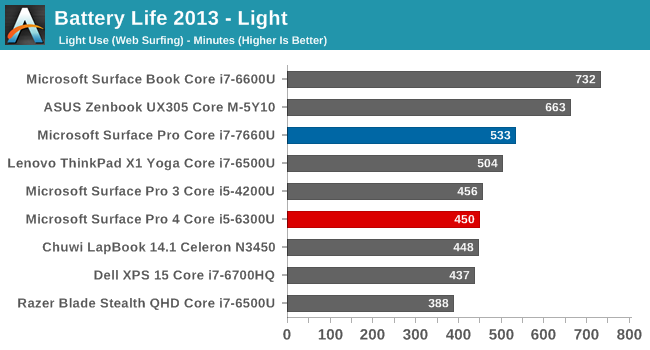
The new Surface Pro does offer longer battery life than the old model, and the gap isn’t insignificant either. This is almost nine hours of uptime at 200 nits, albeit with a very light test. This is with the device set to best battery life, so there’s going to be a boost from that as well.
Battery Life 2016 – Web
Our newer web browsing test is much more demanding, but due to the review schedule, it’s mostly been run on larger gaming laptops only. Consequently there are fewer Ultrabooks to compare it against, but we do have a couple of other machines we’ve tested.
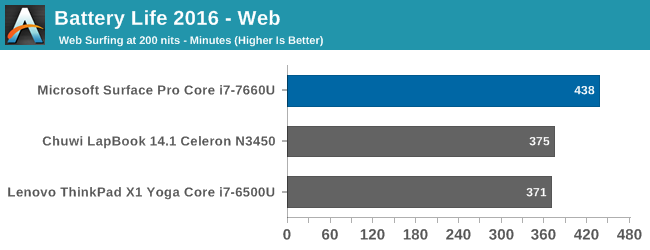
Despite having a smaller battery capacity than the ThinkPad X1 Yoga, which has a 52 Wh battery, the Surface Pro picked up more than an hour of battery life with the display set to 200 nits. This is a strong result, and highlights the efficiency that Microsoft has been able to achieve.
Normalized Web Browsing
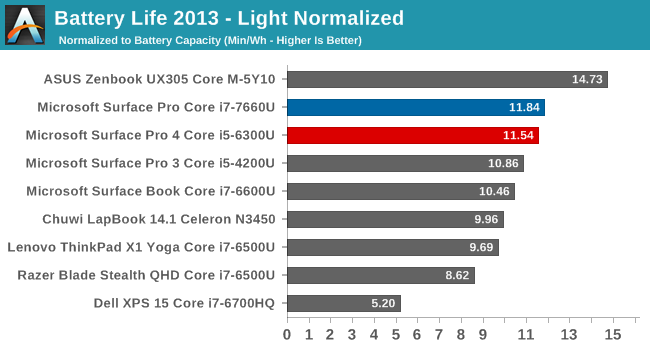
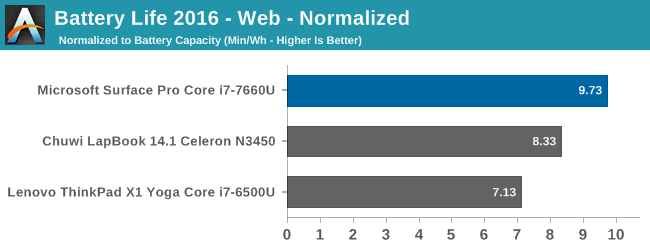
Removing the battery capacity from the results gives a picture of overall device efficiency, and here the Surface Pro really shows what it can do. It’s well ahead of the ThinkPad, which had a Skylake i7, and even ahead of the Atom powered Chuwi LapBook, which utilizes four Goldmont cores.
Looking at the older 2013 test, where there is more data points, the results are very positive. The overall efficiency has ticked up slightly, despite this using a Core i7 CPU and Iris graphics, but the device was set to Best Battery Life, so the maximum power draw would have been trimmed. Surface Pro continues to be one of the most efficient devices we’ve tested. That being said, the majority of the battery life gains are from the increased battery capacity, which is not unsurprising, since the CPU architecture hasn’t changed.
Movie Playback
Microsoft quotes the new Surface Pro at up to 13.5 hours of battery life, and when they quote that value, it’s using local video playback as the source. It would be great to see companies not use video playback as the only source of battery life results, since all of the video functions are offloaded to fixed function hardware on the CPU, allowing the CPU to go into a low power state (and movies, typically darker, also play better with CABC). This exaggerates the results, even though they are technically valid. Most people buying a Surface Pro are likely to be doing more than just watching movies on it, so a more comprehensive test from the Redmond company would likely provide better real world results.
We do run a movie playback as well though, since it’s really a best-case scenario for any device, but we run it with the display set to 200 nits, whereas Microsoft doesn’t quote its screen brightness value.
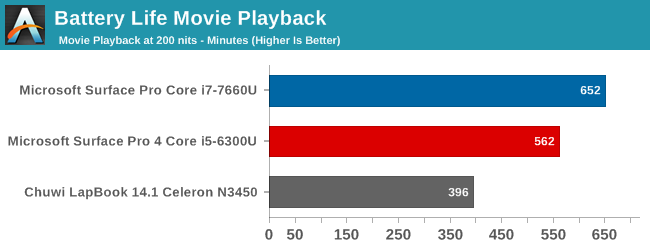
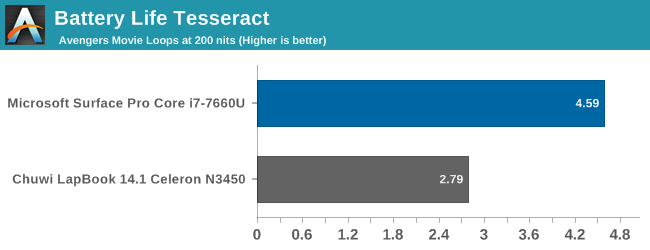
There’s a significant jump in overall battery life on the Surface Pro compared to the previous generation, and we were able to get almost 11 hours of battery life playing back a movie. It’s not quite the 13.5 hours quoted by Microsoft, but it’s close, and we likely run the display brighter. Compared to the Surface Pro 4 though, efficiency doesn’t change very much, and most of the extra life is thanks to the larger battery. That’s not a bad thing of course, since the extra battery capacity is very much welcome.
Charge Time
The new Surface Pro comes with the same 44-Watt adapter, which connects over the magnetic Surface Connect port. The charging adapter also includes a full-size USB port, allowing you to charge other accessories at the same time, without having to take up the single port on the Surface Pro. It is a compact and quiet AC adapter.
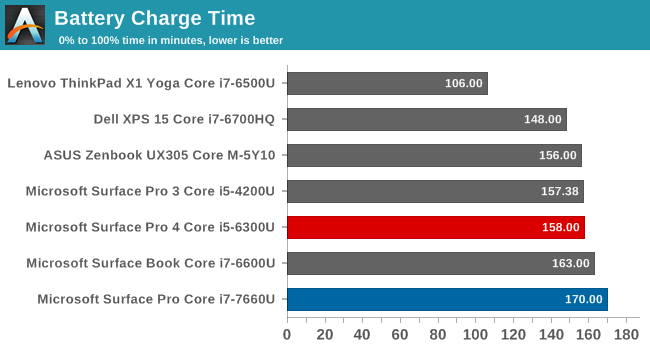
With a slightly larger battery size than the outgoing Surface Pro 4, it’s perhaps no surprise to see that the charging time has increased by a few minutes over the old model. It’s able to hit 50% in just over an hour, and 93% charge in two hours.


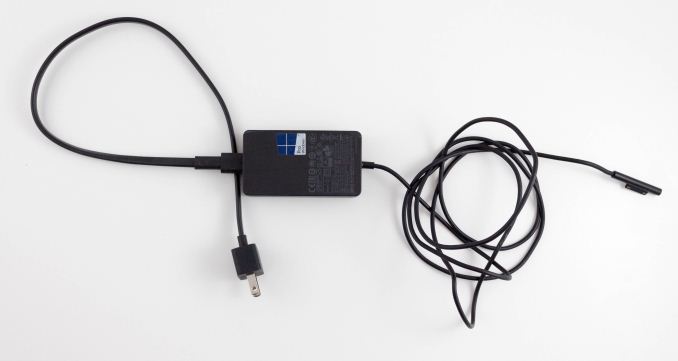
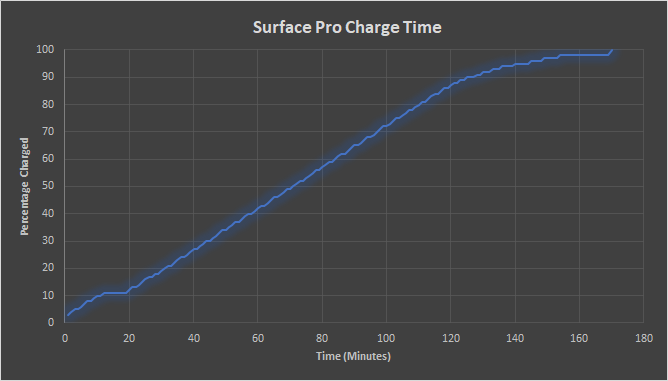








124 Comments
View All Comments
mkozakewich - Saturday, June 17, 2017 - link
I swear I say this every time, but it bears repeating: One of the original ideas about ultrabooks was that we could throttle them while mobile, but then run them at full power by using some kind of cooling dock. Same thing here: If you had (or made?) something that cools off the chassis, it'll reach higher performance levels. Using it outside on a cold and windy day will give you more frames per second. Stuff like that.tipoo - Monday, June 19, 2017 - link
Yup, very interested about the fanless 15W i5 and how well that can keep up. In theory it would act pretty Core M-ey.anactoraaron - Thursday, June 15, 2017 - link
I remember owning a pro 4 and being disappointed learning that the review samples used a faster ssd. All retail units had much slower ssds and a ridiculous amount of light bleed on the displays. I had one at launch (and returned a few to try and get less light bleed and perhaps the faster ssd used by the review units) but the first time I got a blue screen negating over an hour of work it had to go. It was a great concept, as I ultimately went with the Vaio Z Canvas (during the fire sale). The Vaio has been by far the better option, with plenty of ports and power (not to mention it also has a better display) to its advantage over the surface pro.SaolDan - Thursday, June 15, 2017 - link
I actually owned a sp4 i5 with the toshiba ssd and it had faster write. about 1GBps write speed. But tbe screen developed a small preasure point and i got it replaced. I got a samsung ssd on the replacement. not as fast.samnish - Thursday, June 15, 2017 - link
As an owner of Surface Pro 2 and 4, I must say, I went from loving the idea to hating the series. To list a few issues:- Normal sleep mode never works. Either it wakes up to a black screen, or it used up all the battery while sleeping. It is pretty much required to disable sleep and use hibernation instead.
- The Wacom pen on SP2 worked well. The one on the SP4 is a huge step downwards. If you want to draw a straight line, you need to draw it by the edge of the screen, because when you draw in the middle of the screen it'd give you a squigly line. Happaned even after exchanging for another one at MS store.
- On the SP4, I encountered a bug where a process "Microsoft IME" would hog up 100% of the CPU. If memory serves, it was introduced by the Anniversary Update. After a lengthy thread on Microsoft forum with many other victims, MS did fix it. But it took them 3 months.
- When charging, if the SP4 is grounded slightly different than myself, the touchpad would have an jittery response. I have to touch the chassis of the SP4 with my other hand to make the touchpad work normally. Happaned even after exchanging for another one at MS store.
This is enough examples. The Surface Pro series was Microsoft's poster child, yet they couldn't even get all the basic laptop features working stably for 4 generations. With laptops from other manufacturers, one can defend MS by saying "they have many different hardware to support, drivers take time to mature". Sure. What about the Surface Pro series? You can't really defend them with the same points - all the hardware is chosen and supported by Microsoft themselves. By Surface Pro 4, they really shouldn't still be struggling with delivering firmware that don't break your hardware and a sleep mode that works. I hope the new Surface Pro fares better this time on these departments, but I don't have high hopes for them. Microsoft has a much stronger showing for innovation in recent years, yet the hardware that they deliver are full of small glitches, and the stability of their consumer operating system has been such a mess.
mkozakewich - Saturday, June 17, 2017 - link
I had a lot of problems with the little things. When I close my cover, the touchpad starts activating the screen, causing it to wake from sleep or start dragging icons around. I'm actually having a more consistent time with my $400 Chuwi. It feels weirdly magical to be able to close it without worrying about it waking up again.tipoo - Thursday, June 15, 2017 - link
Pretty curious about that 15W fanless middle tier. I'm assuming it would act pretty Core M-ey, but I wonder if it would do worse than silicon selected for the lower TDP, or if the chips are pretty much the same with different TDP-Downs.id4andrei - Thursday, June 15, 2017 - link
The Core M SP4 had great cooling. As long as the fanless i5 throttles at about the same threshold as ultrabooks with fans it would be a success.KPOM - Sunday, June 18, 2017 - link
The 15w cpus can downvolt to 7W. I wounded if that is what Microsoft is doing with the i5.tipoo - Monday, June 19, 2017 - link
Yeah that's what I meant about the TDP-Down, in theory a 15W chip with a tdp-down to 7W and a 5W chip with a TDP-up to 7W would act the same as the silicon is the same.